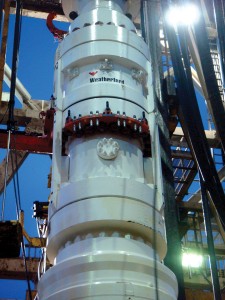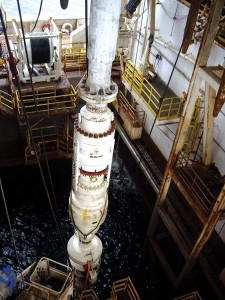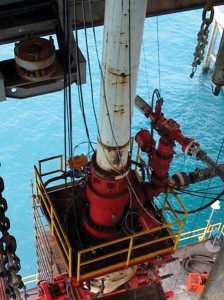RCD for DP drillship takes MPD deeper
Rotating control device is made up below tension ring and integral to riser package, has been deployed in 6,000 ft-plus water depths
By Julmar Shaun S. Toralde, Weatherford International

Managed pressure drilling (MPD) recently took a big step into deepwater environments with the installation and utilization of the industry’s first rotating control device (RCD) made up below the tension ring and integral to the riser package of a dynamically positioned (DP) drillship. As of June 2011, the Weatherford Model 7875 Below-Tension-Ring (BTR) SeaShield RCD has been successfully deployed on three rank wildcat deepwater wells in Indonesia at water depths of more than 6,000 ft.
The RCD is a key component of the deepwater MPD system that contains annular flow and redirects it to help form a closed-loop circulating system. Designed for use on a DP drillship, the system optimizes the drilling process with a closed-loop circulating system. It provides early kick and loss detection and enhances the riser gas-handling system by allowing early detection of riser gas breakout and facilitating pressure control for the same. The system also enables pressurized mud cap drilling (PMCD) in the event that severe circulation losses are encountered when drilling through carbonate formations.
In the configuration used for the pro ect, the RCD forms part of what is called an MPD riser joint – together with a surface annular BOP and a flow spool – that is installed through the rotary table when the riser and BOP are deployed. Another major component of the deepwater MPD system is the Microflux control MPD choke manifold, a specialized 5,000-psi manifold equipped with dual chokes and instrumented with a Coriolis mass flowmeter and precision pressure sensors.
For this application, the Model 7875 BTR RCD is installed above the intermediate riser joint and below a standard slip joint about 140 ft below the rig floor and roughly 40 ft below sea level. Hydraulic and electrical connections below the water line are made via a subsea-rated hydraulic stab plate. The plate, which is connected to a dedicated 300-ft long umbilical cable, features multiport connections that speed line deployment and makeup while eliminating multiple control cables.
The BTR RCD is the first RCD designed and field-tested to support riser tension requirements of as much as 3 million lbs. Prior MPD operations aboard floating vessels have been configured with a surface RCD above the water line and the tension ring. Because the new RCD is made up below the tension ring, no modifications are required to the riser’s telescoping slip joint or the rig’s mud returns system.
The device allows conventional use of the riser with full-bore access to the well and provides the flexibility to easily transition between conventional and MPD drilling methods. The RCD bearing assembly, with an OD of approximately 19 in. (492 mm), is deployed through the rotary table and tension ring components. With the bearing assembly removed, the RCD is capable of handling full-size 18 3/4-in. BOP tools.
The inside profile of the RCD body contains a hydraulic latch that is designed to receive, retain and release the bearing assembly with locking dogs. These locking dogs use a C-latch type system, which is more resistant to debris and solid intrusion. It has a 21 1/4-in. x 10,000 psi API flange on the top and at the bottom.
The BTR RCD has a logging adapter that can be installed in lieu of the bearing assembly on the RCD body, thereby providing a means of logging under pressure through the RCD in a safe and controlled manner.
The BTR RCD also comes with a contingency RCD system that uses a specialized housing that allows for the RCD system to be landed in the annular BOP. Using the contingency RCD system allows MPD operations to continue even if the seals on the RCD body have been compromised.
It is basically an RCD bearing assembly made up to a long tubular extension below it. The specialized housing is run in until it sits on a profile on the RCD body and until the housing’s extension has already passed through the surface annular BOP below it. The surface annular BOP is then closed on the extension, thereby providing the seal required for closed-loop drilling while the bearing assembly above it facilitates rotation of the drill pipe without relaying rotation to the surface annular BOP.

The RCD used in this project is the first of many in the Weatherford fleet that complies with and is certified to the drill-through specifications of API 16 RCD. Using this industry standard, the RCD has been rated to static and dynamic pressure ratings of 2,000 psi and 1,000 psi (at 100 rpm), respectively.
In order to put in proper perspective, the significance of the development and deployment of the submerged RCD system, a historical overview of the evolution of the offshore RCD applications is provided below.
RCD Evolution for Offshore Applications
The RCD has gone through a long and arduous evolution process to reach the point where it can offer deepwater MPD capabilities to all the types of floating rigs, including those that are dynamically positioned.
Weatherford performed the first documented RCD application on a floating structure in 2004 using a high-pressure Model 7100 RCD. The application aboard a submersible rig was aimed at drilling Malaysian carbonate formations where high fluid loss was a problem. This use advanced the adoption of the technology to a floating rig platform. The concept was called RiserCap, as the RCD was installed on top of the riser during MPD operations. The technique was successfully used and replicated in other floating drilling units in other areas, even in drillships of the moored type.
The RiserCap system, however, has significant limitations due to the RCD being designed for surface applications on land and fixed rigs offshore. Because the pass-through size of the RCD does not allow passage of the BOP test plug, the RCD and its ancillary components must be rigged down when testing the BOP. It also limits the use of the RCD, and consequently MPD, to the lower and smaller hole sections of the well, which runs against the mindset of deepwater drilling operations, where larger hole sizes and contingency casing strings are the norm.
The riser slip joint also needs to be in the fixed and collapsed position in the RiserCap application to allow for a higher pressure rating for the system. This compromises the heave compensation system of the floating drilling installation involved.
Difficulties were also encountered with RiserCap methods in relation to transitioning from conventional to MPD operations with the RCD in place. The RCD involved in a RiserCap system does not have an upper flange, and when installed it removes that ability to route returns through the rig diverter. Instead it sends returns through the return line attached to the outlet of the RCD. This renders useless certain components of the conventional well-monitoring system and makes it more difficult for the rig crew to adapt to the new system.
An intermediate solution to the issues identified with the RiserCap system was introduced in 2008 with the deployment of Weatherford’s first SeaShield series RCD. Devices in this series are purpose-built for harsh offshore environments and have features that enable full integration into the riser.
Compared with a typical surface application where the RCD sits atop the BOP and requires only a bottom flange to bolt it to the stack, integration with a riser system above a subsea BOP required a new RCD design that could be connected at the bottom and the top. In the docking station (DS) versions of the SeaShield RCD, the device is equipped with a top flange that makes installation and integration with the marine riser system possible. This allows the RCD to remain connected to the rig diverter housing at all times. In this set-up, the slip joint is placed higher in the riser string, with the RCD and an annular preventer with a flow spool now situated below the slip joint.
Using the Model 7875 DS system, the RCD bearing and packer assembly is installed through the diverter housing and marine riser system when operations need to shift to MPD mode. This rig-up allows the well to be drilled conventionally with all of the MPD equipment already in place. Once MPD operations commence, the bearing assembly is installed, the valves are opened and drilling can resume in MPD mode without any further rig-up requirements. In circulating mode, returns are taken up the flexible flow line. If PMCD operations are required, cap fluid can be injected through the flexible flow lines.
More importantly, the design of the earlier Model 7100 RCD required the presence of service personnel in the moonpool area at times when the RCD is in use, thereby exposing personnel to a higher degree of risk. The challenging physical location of the RCD far below the rig floor makes it difficult to deploy personnel and presents a higher-risk work environment. It also makes new demands on installing, maintaining and operating an RCD.

In a significant design advance, the Model 7875 DS enhances the safety of offshore MPD operations by using a remotely operated hydraulic latching system that allows bearing and sealing elements to be changed without the need for personnel in the moonpool area. A special running tool for the bearing assembly and ancillary equipment facilitates rig-floor positioning and removal.
However, both the RiserCap and Docking Station applications are only feasible and practical on moored floating rigs, as the RCD normally has hoses, piping and valves connected to it that need to pass through lines attached to the tension ring. This set-up does not translate well when considered on a dynamically positioned vessel, as the MPD ancillary equipment will end up snagging the lines when the vessel rotates.
Installing the RCD below the tension ring surmounts this difficulty and facilitates rig rotation by keeping the hoses and other RCD components away from the tension lines.
Installation of the RCD below the tension ring also increases the pressure rating of the MPD system by removing the slip joint, which has been the challenge in previous applications of MPD from floating vessels. Another technical hurdle that needed to be addressed was the need for the RCD to withstand tension. This was readily addressed by outfitting the BTR RCD with 21 1/4-in. x 10,000 psi top and bottom flanges.
Finally, placement of the RCD below the tension ring also required that the equipment and all its connections be able to withstand and operate while being submerged in seawater for an extended period of time. As a result, the connections on the BTR RCD stab plate were designed and rated for subsea use.
Deepwater MPD and Beyond
In 2010, the SeaShield series Model 7875 BTR became the industry’s first RCD to be installed on board a dynamically positioned drillship as an integral part of the riser. The success of this equipment and its application marks a significant point in the extension of MPD safety and operational enhancement capabilities into the high-risk, high-cost environment of deepwater drilling and specifically to drilling rigs that have dynamic positioning capabilities. More importantly, the successful deployment of the BTR RCD also positions MPD for further expansion into the territory of ultra-deepwater drilling (at water depths greater than 7,000 ft), especially when dynamically positioned drilling units are involved.





Is the load rating of 3 MMlbs in addition to the 2000 psi dynamic pressure ?